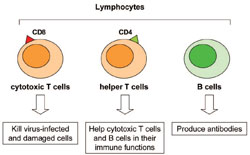1.1.1 How does the immune system protect us from infection?
In this section, you will learn about the different ways in which people can acquire immunity (become immune) to infectious agents. Immunity may be non-specific or specific.
Non-specific immunity
Non-specific immunity (also known as innate immunity — ‘innate’ means ‘already formed at birth’) includes protection from infectious agents by mechanical barriers, such as intact skin or the mucus membranes lining the inside of our nose, mouth, lungs, reproductive system and gut. It also includes the actions of some kinds of white blood cells that can engulf (‘eat’) or kill a wide range of infectious agents, without distinguishing between them.
Specific immunity
In this study session, we will focus on specific immunity, which is the type generated by immunization. Specific immunity is produced when the immune system reacts specifically against one particular type of infectious agent in ways that we will now describe.
When bacteria, viruses or other pathogens get into the body, they are identified as ‘foreign’ by special white blood cells in the immune system, known as helper T lymphocytes or helper T cells (Figure 1.2). Infectious agents are recognised as foreign because they have unique proteins — called antigens — on their surfaces, which the helper T cells can detect. Each type of infectious agent has its own unique antigens, so the person’s immune system can tell which type of infectious agent has got into the body, and direct an attack specifically against that pathogen. Some infectious agents release antigens into the body fluids of the organism and the helper T cells detect these too. Thus, a simple definition of an antigen is any substance that is foreign to the organism that is exposed to it, and which the organism’s immune system can detect specifically and attack.
You learned about the family of white blood cells called lymphocytes (pronounced ‘lim-foh-sites’) in the study sessions on HIV/AIDS in Part 3 of the Communicable Diseases Module.

The surface molecules labelled CD8 and CD4 are unique ‘markers’ of these cells
The helper T cells activate (‘help’) the rest of the immune system to attack the specific infectious agents they have detected in our bodies. In particular, they help two other types of lymphocytes shown in Figure 1.2. The cytotoxic T cells kill our own cells which have become damaged or infected by viruses.
The B lymphocytes or B cells make special proteins called antibodies in response to infectious agents getting into the body. Antibodies are proteins made by B cells, which circulate in the blood or body fluids and attach to the antigens in (or released by) infectious agents. Infectious agents that have antibodies attached to them are neutralised, or destroyed, by the person’s immune system.
The helper T cells also cause the production of long-lived memory cells, which circulate in the body for years, sometimes for the person’s whole life. These cells ‘remember’ that they have met the infectious agent in the past — either during an infection, or through immunization — and they direct a rapid and effective immune attack against it if it ever gets into the body again.
1.1 Immunity and the immune system
